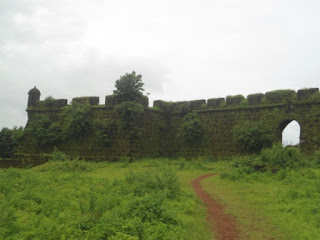There were a few items that I needed to pick up in Mapsa, the 50,000 population city about 30 kilometres south from Arambol. One item was a guitar string...yes, I’m learning to play guitar but more on that in the next blog entry.
After my errands, I looked at a map in the Lonely Planet guide for Goa (which I have thanks to my Dutch friend Marian leaving behind for me back in January) and decided to do some scooter exploration to the east of Mapsa. There is an island created by a couple of rivers called Corjuem. I noticed that there was a fort on the island and read that it was the furthest inland fort that the Portuguese built (most, not surprisingly, are situated on the coast). Fort Corjuem was built in 1705 to protect the area from Raids by the local Rajputs and Marathas.
Leaving Mapsa, I wasn’t totally sure of which road to take but I’ve found in Goa that if you just head in the general direction you will usually end up where you wanted to be. I asked a few locals for directions as I progressed (yes, I have suppressed that male gene) and as I rounded one corner I saw a large cable stayed, very modern looking bridge about a kilometre away. I was a little surprised at its size but later realized that it serves as a link from Mapsa to the town of Bicholim.
The impressive cable stayed bridge:

Just after crossing, I came to a fork in the road and contrary to Robert Frost’s advice, I took the road more travelled. I rode up a slight hill and after a bit of meandering, crested the hill and saw another, less impressive bridge over a river on the other side of the small island. “Hmm...did I miss the fort?” I stopped and asked a man in his thirties walking down the road and he said “It’s right there.” And pointed just off the side of the road. I was not 200 meters from it and would have easily missed it! This near oversight was partially due to the fact that it’s a short and squat fort but also because the local vegetation is putting in its best efforts to reclaim it. The whole place could be considered a “chia-fort”.
"Chia-Fort":

I spent about 20 minutes wandering around inside. There’s really not much to see but some of the views from up on the ramparts were nice: the meandering river, the lush vegetation and a large red hill off in the distance (which actually wasn’t that nice as it is being mined for its iron but at least a bit interesting). In fact, the thick walls of the fort were constructed of the locally found laterite which is soil rich in iron, aluminum and other minerals that gets cemented together and can easily be shaped using a shovel into large bricks. They are still heavily used today in the construction of houses.
The only way in or out:

I looked back inside the fort from up on the parapet and tried to imagine 50-100 soldiers living inside the small area, maybe 30 meters square. I would have thought that it would have been easy for raiders to simply surround the small fort and starve them out (or “parch” them out as the river was about a kilometre away). Couldn’t have been much fun to be a soldier back then. Supposedly a Portuguese woman, Ursula e Lancastre, who was determined to succeed in a man’s world, posed as a soldier and was stationed at the fort. I think I might have done the opposite and dressed as a woman to avoid being posted there!
The inside of the fort:

Another thought popped into my head as I gazed around the interior of the stronghold with the four ramps in each corner...where are my bocce balls?!?
Yes, I am squinting a bit:

I left the fort and continued towards the less impressive bridge I saw earlier, figuring I would try and find a new way back towards Arambol. My map wasn’t terribly detailed and somehow I ended up going a bit further east to Bicholim, a town of 15,000 people with the mining industry driving the local economy. I toured around a bit, found some gas for the scooter and watched a bit of a teenage football game (that’s soccer for my North American friends...yes, I’ve been away long enough to start calling it by its proper name!) on a puddle ridden pitch before I rode my way back to Arambol Beach.
A main intersection in Bicholim:

This dog thinks he's a cow, and yes, they are all lying in the middle of the street:

The Bicholim bus stand...a typical bus stand in India:

On my way back to Arambol, at Aswem Beach:


Hey Dave...are you still in Arambol?? I am planning to visit next week ..Lemme know if you could help me with travbuddy willing to share the accomodation
ReplyDelete